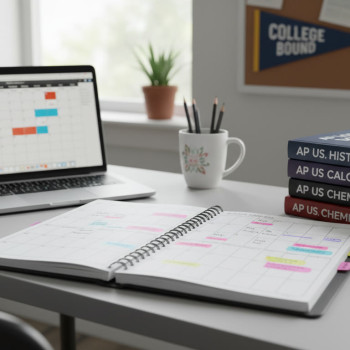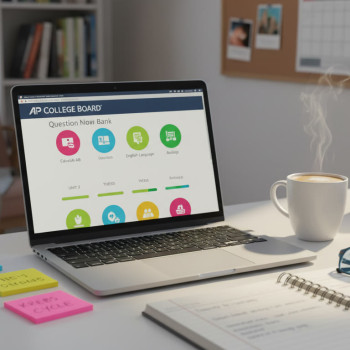Why APs and Post‑Bacc Experience Matter — and How They Fit Together
If you’re a student (or the parent of one) plotting the path to selective colleges, you’ve likely heard about Advanced Placement (AP) courses and post‑baccalaureate (post‑bacc) work. Both can strengthen an application, but they do different jobs. APs show colleges that you sought rigorous coursework in high school and can manage college‑level material early. Post‑bacc experiences—whether academic, research, or professionally oriented after graduation—demonstrate maturity, focused interest, and academic momentum beyond the typical timeline.
Understanding how the two interact lets you build a cohesive narrative for admissions readers: early intellectual curiosity (APs) combined with depth and refinement later (post‑bacc). This blog walks you through practical timelines, study strategies, and real‑world tips for combining AP background with a post‑bacc plan that impresses top colleges.

Start with a North Star: Define Your Academic Story
Before diving into lists and calendars, ask a simple question: what story are you trying to tell? Top admissions offices favor a coherent narrative. Are you a budding biologist who took AP Biology, led a lab internship, and later pursued post‑bacc research? Or an aspiring economist whose AP Calculus and AP Microeconomics classes evolved into policy internship work after graduation?
When APs and post‑bacc work complement each other, they form a compelling arc: exposure → dedication → expertise. Use APs in high school to explore and demonstrate aptitude; use post‑bacc opportunities to show sustainability, specialization, and real outcomes (publications, presentations, or demonstrable projects).
Timeline: When to Take APs and When to Consider Post‑Bacc
There isn’t a single right path, but here’s a practical timeline to keep you on track.
| Phase | Typical Timing | Objectives |
|---|---|---|
| Exploration | Freshman–Sophomore year (High school) | Try introductory APs (e.g., AP Human Geography, AP World History); build study skills. |
| Acceleration | Junior year | Take core APs (English, Calculus, Biology/Chemistry, US History); aim for strong scores; begin thinking about colleges. |
| Capstone | Senior year | Finish AP schedule, submit college applications, or plan academic gaps thoughtfully if considering post‑bacc work later. |
| Post‑Bacc Planning | After undergrad (or as a gap year plan) | Choose post‑bacc to deepen knowledge (research, coursework, clinical prep), especially if you need to strengthen preparation for graduate or professional school. |
Quick Practical Notes
- AP Exams: register early with your school’s AP coordinator; schools typically place ordering deadlines in the fall. Missing the school’s deadlines can complicate registration.
- Balance is key: taking every AP available can backfire if it sacrifices depth or grades. Quality often trumps quantity.
- If you’re considering post‑bacc options, keep records: syllabi, project summaries, and faculty contacts will help you later when you need recommendations or to explain your trajectory in essays.
Designing an AP Course Load That Strengthens Your Application
Not all APs carry equal weight for every major. Smart scheduling means aligning choices with intended future study while preserving mental bandwidth.
STEM Focus
- Prioritize: AP Calculus AB/BC, AP Biology, AP Chemistry, AP Physics, and AP Computer Science (if relevant).
- Tip: If you take AP Physics 1 early, follow with Physics C only if you’re committed to STEM; otherwise, maintain consistency with lab experiences and math rigor.
Humanities & Social Sciences
- Prioritize: AP English Language and Composition, AP English Literature, AP US History, AP World History, AP Government, AP Psychology.
- Tip: AP Seminar and AP Research (where available) are golden for building research and writing portfolios.
Arts and Interdisciplinary Paths
- Prioritize AP Art and Design, AP Music Theory, AP Comparative Government, or language APs that show cultural depth.
- Tip: Portfolio work, performances, and long‑form projects often matter as much as AP scores in the arts.
Study Strategies: From AP Classroom to Exam Day
The College Board offers AP Classroom resources and practice materials. Combine those official tools with deliberate study systems to maximize results.
Proven Routines
- Plan Backwards: Start from your desired exam date and build weekly milestones.
- Active Retrieval: Use past free‑response questions and practice multiple‑choice under timed conditions.
- Project Focus: For AP Research or seminar, treat the course like a mini thesis—schedule drafts and advisor check‑ins.
- Peer Teaching: Explaining a concept to a classmate reveals gaps faster than solo review.
When to Seek Extra Help
Struggling with conceptual gaps in calculus or lab technique? That’s exactly when targeted support helps. One‑on‑one tutoring can zero in on weak spots and set a personalized plan. Sparkl’s personalized tutoring—offering 1‑on‑1 guidance, tailored study plans, expert tutors, and AI‑driven insights—can be a game changer when you need structured, efficient progress without wasting study hours.
Using AP Scores Strategically for College Applications
AP scores tell an admissions reader about preparedness, but they’re only part of a profile. Think of APs as evidence supporting the story you want to tell.
How Colleges Use APs
- Evidence of rigor: High grades in APs show readiness for college academics.
- Placement and credit: Many colleges grant credit or allow you to place into advanced classes, which you can mention in essays as a chance to pursue research or unique majors.
- Context matters: A 4 in a lab‑heavy AP at a competitive school may speak louder than a 5 in a less demanding local context.
Explaining Weak AP Results in Applications
If an AP score doesn’t reflect your capability, use the application to contextualize it—briefly. A well‑placed teacher recommendation or an upward‑trend transcript and later post‑bacc performance can counterbalance a single weak score.
What Post‑Bacc Options Look Like (and Which Fit Your Goals)
Post‑bacc experiences vary widely. Choosing the right kind depends on whether you want to strengthen academics for graduate programs, pivot fields, or gain practical experience.
Common Post‑Bacc Pathways
- Academic Post‑Bacc: Additional coursework to raise GPA or take prerequisites. Choose accredited university courses; keep syllabi and grades for your application packet.
- Research Post‑Bacc: Work as a research assistant or enroll in structured research programs. Look for opportunities producing posters, conference presentations, or co‑authored papers.
- Clinical or Professional Post‑Bacc: For students aiming at medical or clinical programs, these offer patient hours and shadowing alongside coursework.
- Gap Year with Focus: Internships, certification courses, or structured study—if you plan it well, a gap year can be a powerful post‑bacc equivalent.
How Post‑Bacc Strengthens an Application
Post‑bacc work lets you:
- Show upward trajectory—improved grades or test performance after an undergrad that didn’t showcase your potential.
- Deepen specialization—research or advanced coursework tells admissions you’re serious and capable of graduate‑level work.
- Provide new recommenders—supervisors in post‑bacc research or coursework often write the most relevant letters.
Bridging AP Background to Post‑Bacc: Practical Steps
Transitioning from high school APs to impactful post‑bacc work takes intentional planning. Here’s a practical checklist to bridge the two.
- Archive AP Materials: Keep course syllabi, scored free responses, and any high‑quality projects. They’re evidence of early skills and can strengthen later narratives.
- Use AP Credits Thoughtfully: If your college grants AP credits, use the freed time to take advanced electives or research earlier.
- Network with Faculty: Start building relationships early. An undergraduate professor who knows your AP background and later supervises a post‑bacc project creates continuity in your story.
- Plan for Recommendations: Ask teachers who can speak to your sustained interest; include AP teachers if they saw your intellectual growth.
- Document Outcomes: For research or projects, keep concise summaries, data, and any artifacts to show in applications or interviews.
Sample 2‑Year Plan: From Senior Year APs to a Focused Post‑Bacc
The following two‑year blueprint helps students who plan a gap or post‑bacc year after undergrad and want to turn AP momentum into post‑bacc advantages.
| Month/Year | Action | Outcome |
|---|---|---|
| Sophomore Year | Identify core APs to take junior year; begin exploring summer research or internships. | Clear path for AP selection and early applications to programs. |
| Junior Year | Take key APs; join a club or lab; attend summer program in field of interest. | Practical exposure and first‑hand experiences to cite later. |
| Senior Year | Finish APs; solidify college applications; request recommendations from AP teachers. | Strong application with rigorous course history. |
| Post‑Grad Year 1 | Enroll in targeted post‑bacc coursework or research assistant role; collect data and write summaries. | Improved academic metrics and concrete outputs for applications. |
| Post‑Grad Year 2 | Finalize applications for graduate or professional school; leverage post‑bacc recommenders. | Competitive, cohesive application backed by evidence. |
Essays, Interviews, and the Narrative Thread
APs and post‑bacc experiences are powerful content for essays and interviews, but you must frame them. Admissions readers love narrative: what sparked your interest, how you explored it (AP courses, projects), and how post‑bacc work deepened your focus. Use concrete moments—a lab mishap that taught you a method, an AP research paper that turned into a poster—to make your story vivid and human.
When including tutoring or coaching in your journey, frame it as strategic support: show how personalized instruction (for example, 1‑on‑1 guidance and tailored study plans like those offered by Sparkl) helped you master a concept and then apply it in research or advanced coursework, rather than as a crutch.
Practical Resources and Records to Keep
- AP score reports and transcripts (official and unofficial)
- Copies of notable assignments, lab reports, and research summaries
- Recommendation contact info and letters (when available)
- A one‑page summary for each post‑bacc project: goals, methods, results, and your specific contribution
Common Questions Parents and Students Ask
Q: How many APs should my child take?
A: There’s no magic number. Aim for a load that challenges without overwhelming. Admissions officers prefer steady rigor plus high grades over overloaded schedules that lead to burnout. Consider 3–5 well chosen APs across junior and senior years for a balanced profile—more if you can sustain excellence.
Q: Should a weak AP score worry me?
A: A single disappointing score isn’t the end of the world. Use it as a data point: did it reflect poor preparation, bad timing, or a real mismatch? If you need to show improvement, consider targeted coursework or a post‑bacc option that directly addresses the gap.
Q: Can Sparkl‑style personalized tutoring help?
A: Yes—when used strategically. Personalized tutoring that offers 1‑on‑1 guidance, tailored study plans, expert tutors, and AI‑driven insights can close conceptual gaps quickly, sharpen exam technique, and free up time for higher‑level projects that make your profile shine.
Final Thoughts: Think Long‑Term, Be Intentionally Curious
AP courses are your early proof points; post‑bacc work turns proof into depth. Together, they paint a picture of a student who explores widely, commits deeply, and keeps growing. Keep your records clean, choose APs that align with your interests, and treat any post‑bacc year as a laboratory for transformation. Admissions committees love curiosity that becomes expertise.
Practical concierge tip: Combine official AP resources with focused, personalized help when necessary. Structured, expert guidance—coupled with your authentic intellectual curiosity—can make the difference between an application that’s good and one that truly resonates.

With a clear plan and purposeful choices, APs and post‑bacc experiences don’t just pad a résumé—they build a story. Start with curiosity, sharpen it with rigor, and then prove it with sustained, focused work. That combination is what top colleges notice.
Good luck. Study thoughtfully, ask questions early, and remember: preparation is a marathon, not a sprint. When you need tailored study plans or 1‑on‑1 coaching to make your best work possible, look for help that’s strategic, empathetic, and focused on your long‑term story.



















No Comments
Leave a comment Cancel